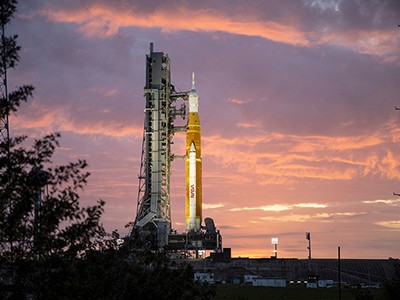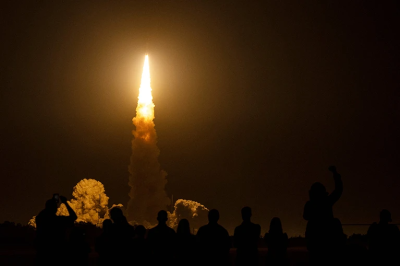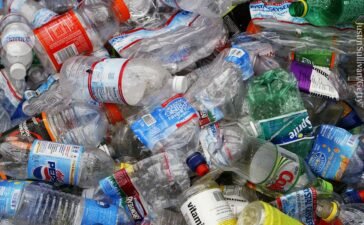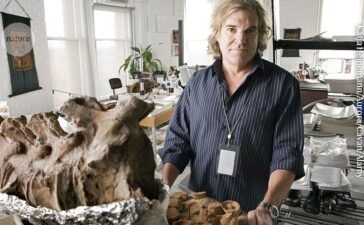HOUSTON, TEXAS
NASA astronaut Kate Rubins was having a hard time seeing in the eerie twilight of the Moon’s south pole this month.
Rubins made her way carefully through the deep shadows on the lunar surface, her path dimly lit by lights on her spacesuit’s helmet. She was hunting through the volcanic landscape for geological treasure — Moon rocks that she could pick up and bring back to Earth, which would reveal secrets of this frozen world. As the first person to set foot on the Moon in more than half a century, Rubins was making good progress on her historic foray — despite the piles of cow manure along the way.
The rock-strewn plain wasn’t really the Moon but was, in fact, the high desert of northern Arizona. Rubins and astronaut Andre Douglas were participating in the biggest dress rehearsal yet for the next time NASA plans to send people to the Moon’s surface, a mission known as Artemis III. If all goes to plan, Rubins or one of her colleagues will be stepping onto the actual Moon a little over two years from now. So NASA is training its astronauts to make the most of their precious time there — given that no human has set foot on the lunar surface since the last Apollo crew blasted off in 1972.
The $93-billion plan to put astronauts back on the Moon
“There’s a lot we need to relearn or figure out,” says Juliane Gross, a planetary scientist at NASA’s Johnson Space Center (JSC) in Houston, Texas, who will oversee the Artemis samples when they come back to Earth. “And so we’re charting the way while we sail it.”
“We’re baking in that scientific rigour very early on that these missions are going to need,” Rubins later told Nature.
During the moonwalking simulation two weeks ago, Gross and other scientists gathered at JSC. It was a massive undertaking that linked astronauts in the field in Arizona with mission controllers and a science team in Houston — working together in real time to choreograph what the astronauts should do on the mock lunar surface. Leading scientists, famous astronauts and NASA brass all showed up to witness the historic test. More than six years after the agency officially kicked off its Artemis programme to return humans to the Moon, it felt as if the Artemis Moon landing was becoming real.
Geology class
If NASA manages to pull off an Artemis III landing, it will have taken some US$100 billion to develop the rockets, crew capsule, landing system and other equipment. As with the Apollo 11 landing in 1969, in which Neil Armstrong and Buzz Aldrin became the first people to set foot on the Moon, the Artemis III landing aims primarily to get astronauts there and back safely.
But science is an integral part of the Artemis programme, according to NASA. The agency has ramped up its astronaut training to incorporate more field geology, so that crew members can learn how to explore the lunar landscape and determine which rocks to pick up, as well as how to deduce the area’s geological history.
Such training paid off during the final three Apollo missions, when each astronaut had roughly 1,000 hours of science training, says Dean Eppler, a lunar geologist who has retired from JSC. “We look at Apollo as the way to do it because it was very successful,” he says. On Apollo 15 in 1971, for instance, two former test pilots spotted and brought home a gleaming fragment of what turned out to be primordial lunar crust. That sample, nicknamed the Genesis Rock, helped geologists to understand how the Moon solidified from a molten magma ocean more than four billion years ago.
In the 2000s and 2010s, NASA trained astronauts to observe Earth from the International Space Station. Now, through visits to places such as asteroid craters and volcanic terrain, astronauts experience what it will be like on the Moon. “That way they know, when you get to the surface of the Moon — if things are not quite the way you had them in your mind, that’s OK,” says Cynthia Evans, a geologist at JSC who leads astronaut geology training.
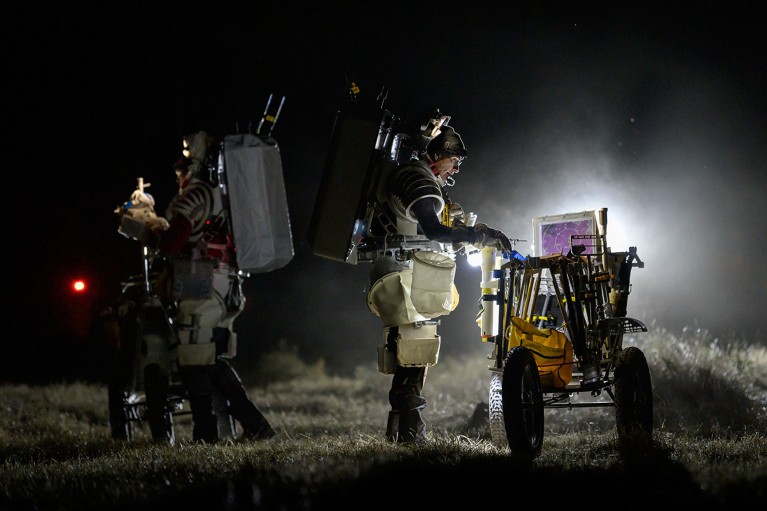
The harsh light at the Moon’s south pole means that astronauts must prepare to work in a strangely illuminated landscape.Credit: NASA/Josh Valcarcel
Artemis III will visit a part of the Moon that has never been explored by astronauts, the lunar south pole. Because of the region’s high latitude, the illumination will be harsh and at a steep angle relative to the surface as the Sun circles the horizon. The contrast between brightly lit regions and deep shadows will make it difficult for astronauts to work in the environment.
Moon cows
Ground zero for the recent exercise in extravehicular activities (EVAs) was the San Francisco volcanic field north of Flagstaff, Arizona, where NASA and the US Geological Survey (USGS) trained Apollo astronauts in the 1960s. This month’s test, known as JETT5 for Joint EVA and Human Surface Mobility Test Team, took place on private land near a cinder cone known as SP Crater. (SP stands for ‘shit pot’, because the crater and its associated lava flow look as if someone tipped over a chamber pot and the contents flowed out onto the landscape.)
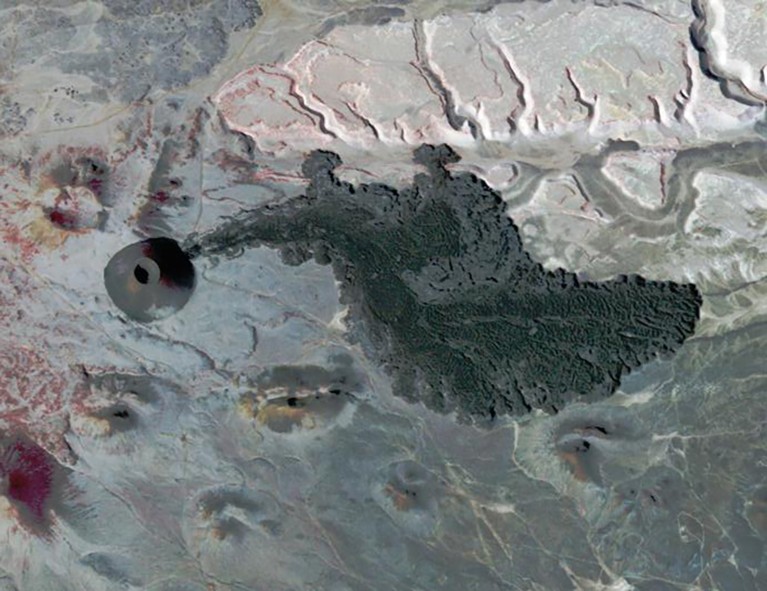
A satellite view of SP Crater in Arizona shows the volcanic crater and lava flow that serve as a simulated Moon landscape for astronauts in training.Credit: NASA/GSFC/METI/ERSDAC/JAROS, and US/Japan ASTER Science Team
Last year, USGS geologists mapped the test area and handed those maps to the researchers who gathered at JSC in a ‘science back room’ during the training exercise. The researchers drew up four simulated moonwalks, each of which ventured from a landing site to explore lava flows, gorges and other geology in the area. “This is very relevant to exactly what we’ll be doing for Artemis,” says Lauren Edgar, a geologist at the USGS in Flagstaff who is co-leader of the JETT5 science team.
During the third of the four moonwalks this month, Rubins and Douglas climbed into spacesuits that mimic what the Artemis team might wear on the Moon. They ‘disembarked’ from their ‘lander’ by walking through a set of orange poles strung with tape — and they were suddenly on the lunar surface, albeit one riddled with ant hills and cow dung.
Rubins and Douglas took photographs and began collecting rocks, radioing their observations back to mission control. They were so efficient at working through their carefully scripted checklists that they were soon running ten minutes ahead.
Some 1,600 kilometres away in Houston, their speed caught the attention of Brett Denevi, a planetary geologist at the Johns Hopkins University Applied Physics Laboratory in Laurel, Maryland, who was serving as leader of the science back room for the evening.
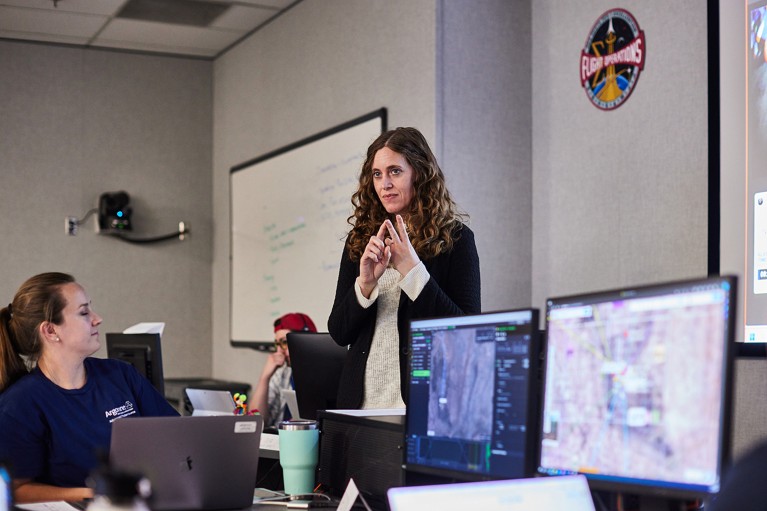
Planetary geologist Brett Denevi consults with other researchers about what NASA astronauts should do during their simulated moonwalk.Credit: Michael Starghill Jr for Nature
Looking for ideas, Denevi asked the science scrum — the informal name for the team members sitting around a map-strewn table. Among them were four scientists, each of whom represented one of JETT5’s main science goals: the study of the area’s surface processes; age relationships between its rocks; its volcanic history; and whether there could be volatile elements frozen in the soil in this simulacrum of the Moon’s south pole. The scrum decided to ask whether the astronauts could collect a drive tube of eroded sediments.
Drive tubes are metal cylinders that allow geologists to collect core samples of soft sediments. During the Apollo era of lunar exploration from 1969 to 1972, NASA astronauts gathered tubes of lunar soil that revealed how cosmic rays pummel the Moon’s surface. Now, Denevi and her team wanted a sample of sediments that had eroded off a nearby rock outcrop. It was a big ask that would require the astronauts to divert from other tasks they had planned.
Each decision during the test had to be justified in real time and carefully documented. “We can’t just say we want that rock,” said José Hurtado, a geologist at the University of Texas El Paso who was Denevi’s deputy for the evening. “We have to elucidate why we want that specific rock and why it ties back to our priorities.”
Denevi walked over to a man wearing a communications headset and passed him a note. “We want to do a single drive tube,” she told him. “Here are the coordinates.”
The scientists’ request was relayed to mission control, which agreed; flight controllers then told the astronauts to go ahead and collect the requested sample. The science back room clocked that as a big win for the evening and erupted in cheers. “We did that!” said one of the scientists at the map table, pumping her arm in triumph. Soon, a series of clinking sounds filled the mission audio feed as Rubins hammered the drive tube into the ground.
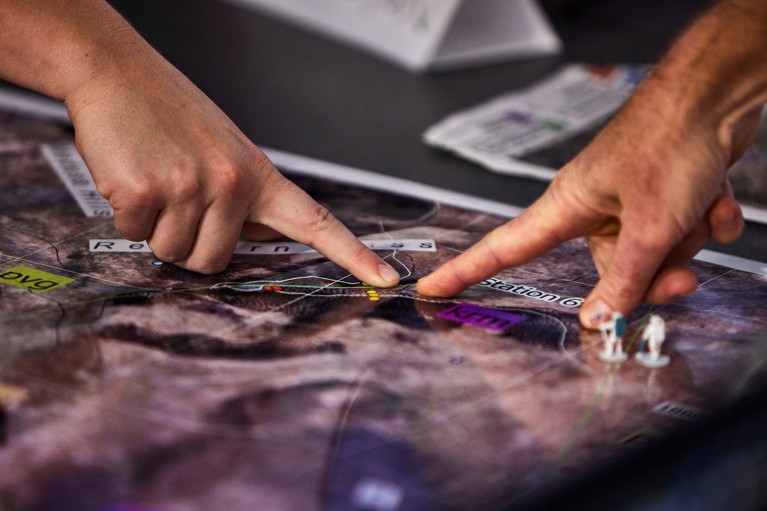
Locating astronauts in real time on the lunar surface is one of the challenges that NASA is working to overcome.Credit: Michael Starghill Jr for Nature
Not everything went smoothly during the night-time EVA. The flight-operations team deliberately built in some challenges, including dropping video communications with the astronauts any time they travelled too far from the lander. An artificial, 20-minute delay on downloading imagery meant that the science team often couldn’t see real-time photos of the rocks the astronauts were picking up.
At one point, Rubins, who is a microbiologist, joked about collecting a piece of cow manure and putting it in a geological sample bag, given that it is ever-present on the Arizona ranch land.
The science back room hummed with activity on multiple audio loops and virtual chats. In addition to the scrum, another group of researchers set up at a neighbouring table to analyse images from the moonwalk, while two other scientists kept track of where the astronauts were.
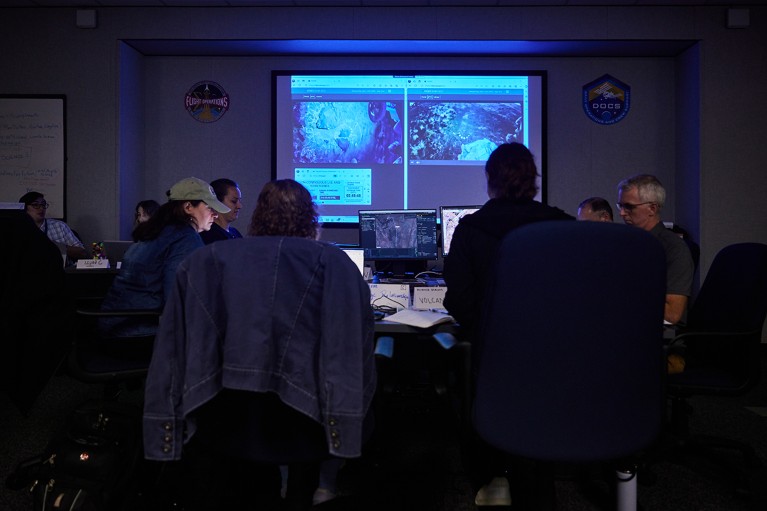
Real-time videos from the ‘moonwalking’ astronauts in Arizona appear on display screens at NASA’s Johnson Space Flight Center in Houston, Texas. Scientists at the centre discuss what the astronauts should do during the training.Credit: Michael Starghill Jr for Nature
Night light
To mimic the lighting conditions at the lunar south pole, JETT5 organizers built a ‘Sun cart’ — essentially a giant spotlight wheeled onto the landscape. To Rubins and Douglas, the light looked like the distant Sun hovering just above the horizon.
The astronauts carefully navigated their way across the dim landscape, relying on a few personal lights to aid their work. Rubins in particular was thrilled to have a handheld light that she could direct where she wanted, in addition to the helmet-mounted lights that pointed only in the direction in which she was looking. “I’m going to call a light that illuminates the area near my feet totally necessary,” she told mission control — feedback that could help astronauts when they reach the Moon.
The point of JETT5 was to develop tools and procedures that will work for Artemis III astronauts on the lunar surface. But many of NASA’s challenges are much greater than working out which rocks to pick up. The Artemis programme has less funding than Apollo did — that programme and its precursors spent more than $300 billion in today’s dollars between 1960 and 1973 — and the planned cadence of Artemis missions is accordingly slower.
Artemis I, an uncrewed test of the heavy-lift rocket and crew capsule to be used for astronauts, was a 25-day space flight that orbited the Moon in late 2022. Artemis II, which will send four astronauts around the Moon without landing, is scheduled for no earlier than September 2025 and the Artemis III landing would be no sooner than September 2026. Artemis IV, another crewed mission to the surface, is pencilled in for 2028. Meanwhile, China has announced its own plans to send humans to the Moon by 2030.
Lift off! Artemis Moon rocket launch kicks off new era of human exploration
NASA has been collaborating with other space agencies on its Artemis plans. Rubins, for instance, has done extra field geology training with the European Space Agency, including at an impact crater in Germany.
“You really want to get your astronauts best acquainted with what they will come across in space in an environment on Earth that you can control and they can learn from,” says Samuel Payler, who helps to lead astronaut science training at the European Astronaut Centre in Cologne, Germany.
At the end of the evening’s moonwalk, Denevi and her team got a surprise of their own. “I forgot to tell you something super-important,” Rubins told mission control as she and Douglas were wrapping up for the night. “I found a really cool rock and I didn’t tell you about it!”
The mystery rock piqued the interest of the science back room. Rubins said it was about the size of a softball, but gave no further clues. The scientists then had to work out how to account for it in their planning, including how much it might consume of the allotted weight of rocks they were able to bring back from the ‘Moon’ during the exercise.
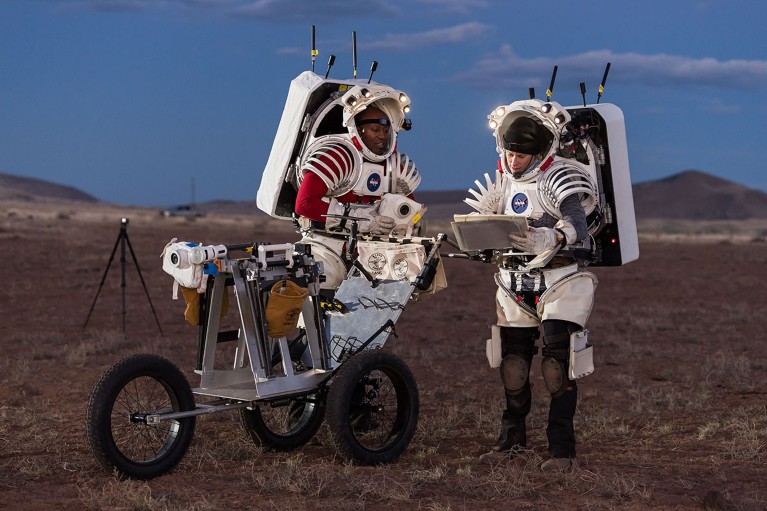
Mock spacesuits and a tool cart mimic the equipment that Artemis astronauts might use on the surface of the Moon.Credit: NASA/Josh Valcarcel
The next night, during the final stage of JETT5, the astronauts pulled off their longest simulated moonwalk yet, at nearly four hours. They had collected about 38 kilograms of rocks and soil, and met their main goals. As the astronauts stowed their Moon tools in Arizona, the science back room in Texas suddenly got a lot more crowded as the flight operations team joined the room for a debriefing session.
Flight controllers described how JETT5 went from their perspective, and the science back room was relieved to hear that the process worked well. “Thank you for allowing us to advocate for science — I think it was powerful to see that happen,” Cherie Achilles, a mineralogist at NASA’s Goddard Space Flight Center in Greenbelt, Maryland, and co-leader of the science team, told the room.
Soon, the scientists were planning for a more extensive debriefing the next day. After that, there would be spreadsheets to finish, documents to finalize and papers to write up.
NASA isn’t planning another big exercise like JETT5 any time soon, but there will be smaller efforts to test specific tools for lunar exploration. If NASA is going to make its Artemis dreams come true, there’s a lot of work to be done.


